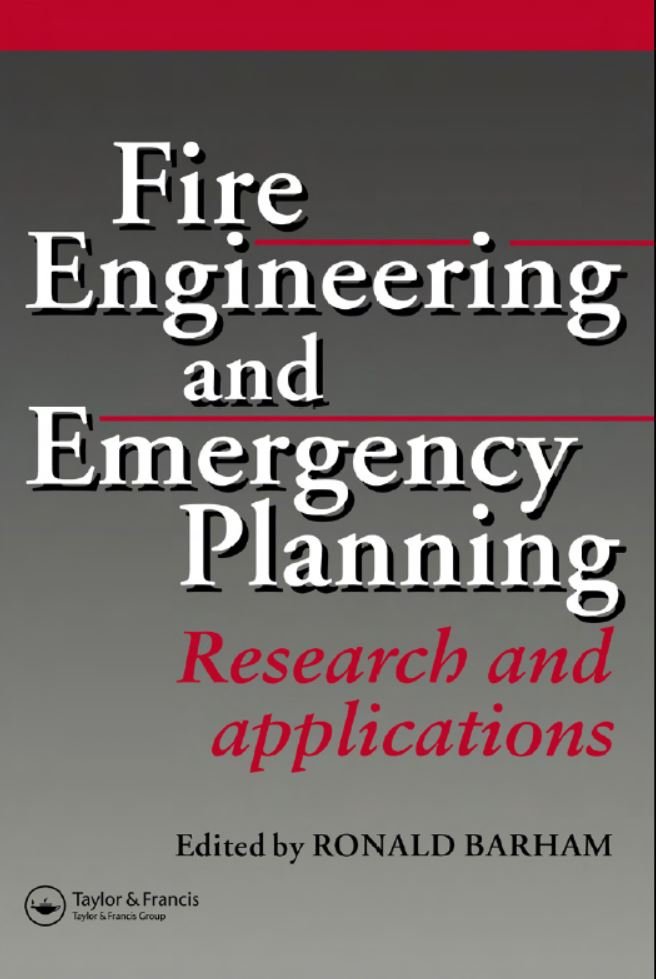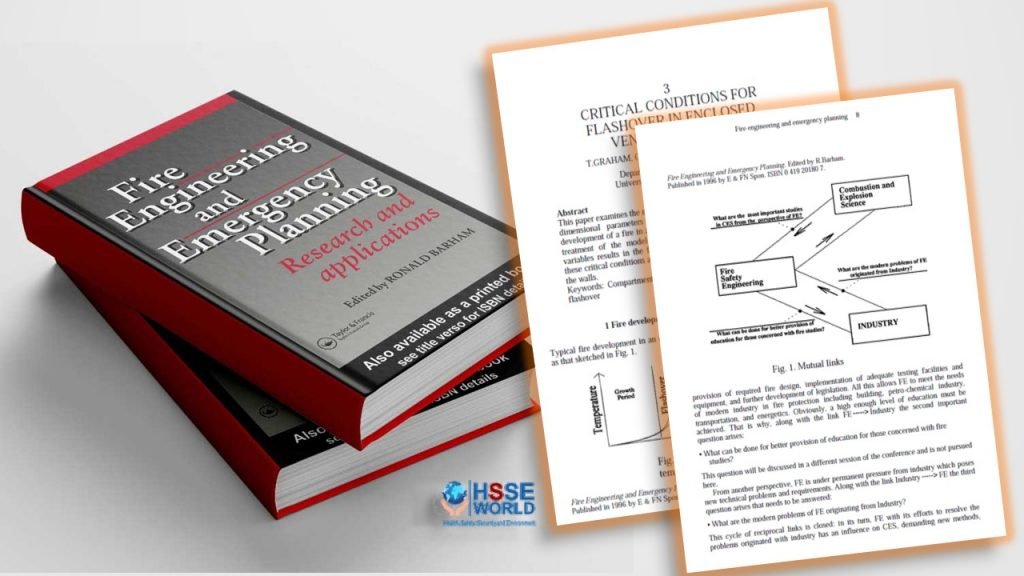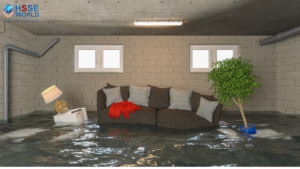E-Books: Fire Engineering and Emergency Planning
5 min readFire Engineering and emergency planning Research and Applications by R. Barham. This book represents the proceedings of Euro Fire 95, the first European Symposium on Research and Applications in Fire Engineering and Emergency Planning. Throughout Europe there is a considerable number of fires reported each year, resulting in the loss of many lives. The amount of damage to the environment and to the property is colossal, with reinstatement work on the non-domestic property often costing hundreds of millions of ecu. Add to this the cost of business interruption and increased insurance premiums and the imperative of lessening the risk of fire, and for good emergency planning, through education and research becomes obvious.
Throughout Europe there is a considerable number of fires reported each year, resulting in the loss of many lives. The amount of damage to the environment and to the property is colossal, with reinstatement work on the non-domestic property often costing hundreds of millions of ecu. Add to this the cost of business interruption and increased insurance premiums and the imperative of lessening the risk of fire, and for a good emergency planning, through education and research becomes obvious.
This book represents the proceedings of EuroFire’95, the first European Symposium on Research and Applications in Fire Engineering and Emergency Planning, held at the
Centre Européen de la Chambre des Artisans et des Métiers (CECAM), Nîmes, France, from the 25th to the 27th of March, 1995. The Symposium was organized by the Department of Built Environment (Centre for Research in Fire and Explosion Studies) of the University of Central Lancashire, England, with the assistance of the European
Commission (Human Capital and Mobility Programme) and the Institution of Fire
Engineers. The intended purpose is to make a start on “bridging the gap” between the various sectors of the European fire community, to promulgate state of the art applications, and to flag up new areas and trends in research and practice.

To begin a discussion on research in fire engineering the mutual links between FireEngineering, Combustion, and Explosion Science and Industry (see Fig. 1) should be considered.
Fire Engineering (FE) is essentially based on Combustion and Explosion Science (CES) which has been providing the necessary background, solutions of principle, new qualitative information, methods, and techniques. Also, it puts forward new concepts for
FE and revises former approaches.
From this perspective, it is important to follow the modern trends in CES that seem promising for FE and could be incorporated into FE research in the near future.

This is the first main question arising when evaluating the research in FE along with the link CES FE (see the sketch in Fig. 1):
• What are the most important modern studies in CES from the perspective of FE? In turn, FE tends to adopt, use, and apply those issues that originated with CES. Eventually, this stimulates new engineering solutions, implementation, and improvement of codes, regulations, and standards, development of proper preventive anti-fire and anti-explosion measures,
Contents
Table of Contents of Fire Engineering and emergency planning
- Introduction
- Research in fire engineering: combustion and explosion science and industrial problems
- The theoretical model of carbonized organic solid fuels combustion
- Introduction to fire safety Management/
- Results comparison of smoke movement analysis in buildings
- Emergency planning
- Assessment and simulation of crowd evacuation issues
- Analyzing evacuation modeling techniques
- Foam and water for the protection of equipment
- European standards for fire safety
- The Health and Safety Handbook
- Fire legislation: a UK view of European fire safety regulation
- Operability analysis as a tool for fire risk evaluation
- Educating firefighters for fire safe design
- Training and research in fire safety
- Public perceptions and risk assessment
- Airborne hazards
Download the book
More Downloads
- E-Books: Healthcare Hazard Control & Safety Management
- E-Books: Safety, Health and Working Conditions Training Manual
- E-Books: Energy Efficiency in Water and Wastewater Facilities
- E-Books: Fire Service Features of Buildings and Fire Protection Systems
- E-Books: Evaluation of Fire Safety free download
- E-Books: PPE for Chemical, Biological, and Radiological Hazards free
- E-Books: Changing the Workplace Safety Culture free download
- E-Books: Site Emergency Planning Workbook
- E-Books: Load Restraint Guide
- E-Books: Essential Practices for Creating, Strengthening, and Sustaining Process Safety Culture
- E-Books: System Safety Engineering and Risk Assessment
- E-Books: Permit-Required Confined Spaces
- E-Books: Is it Safe to Enter Confined Space?
- E-Books: 5-Minute Workplace Safety Talks
- E-Books: Safety Culture and High-Risk Environments
- E-Books: Practical Guide to Industrial Safety
- E-Books: Slip, Trip, and Fall Prevention for Healthcare Workers
- E-Books: Health and Safety at Work Key Terms
- E-Books: Fundamentals of Process Safety Engineering
- E-Books: Gas Detection Hand Book
- E-Books: Occupational health and safety management systems ANSI-AIHA-z10-2012
- E-Books: Hot Work on Drums and Tanks
- E-Books: Human Fatigue Risk Management
- E-Books: Guidelines for the provision of facilities and general safety in the construction industry
- E-Books: Handbook of Training in Mine Rescue and Recovery Operations ( 2021)
- E-Books: Code of Practice for the Safe Use of Lifting Equipment – Edition 9 (Nov 2019)
- E-Books: Free Forklift Health and Safety Best Practices Guideline
- E-Books: Handbook of Hazardous Chemical Properties
- E-Books: Human Performance Improvement through Human Error Prevention
- E-Books: Principles Of Fire Risk Assessment In Buildings
- E-Books: Investigation of Occupational Accidents and Diseases
- E-Books: Radiation Protection and Safety in Industrial Radiography
- E-Books: Basic Guide to System Safety, Third Edition
- E-Books: Food Safety Management-A Practical Guide for the Food Industry
- E-Books: Safety identification: Escape and evacuation plan signs- ISO 23601
- E-Books: Safety at Work
- E-Books: The Safety-Critical Systems Handbook 4th edition
- E-Books: Fundamental principles of occupational health and safety
- E-Books: Fire Safety Risk assessment Guide – Sleeping Accommodation
- E-Books: Mental health at work series
- E-Books: Live Fire Training: Principles and Practice
- E-Books: Pre-Startup Safety Review Guide
- E-Books: Fire and Emergency Drill Manual and Building Inspection Guide
- E-Books: Health and Safety: Risk Management 5th edition
- E-Books: Fire Protection systems -Third edition 2021
- E-Books: Fire Safety Logbook templates
- E-Books: From Accidents to Zero
- E-Books: Electric Safety Practice and Standards
- Your steps to chemical safety
- E-Books: Ergonomics and Psychology Developments in Theory and Practice
- E-Books: HAZOPS Should BE fun-The Stream-Based HAZOP
- E-Books: Safety Health and Environmental Auditing
- E-Books: A Quick Guide to Health and Safety
- E-Books: Occupational Ergonomics A Practical Approach
- E-Books: Job Hazard Analysis A Guide for Voluntary Compliance and Beyond
- E-Books: Electrical Safety of Low Voltage Systems




2 thoughts on “E-Books: Fire Engineering and Emergency Planning”